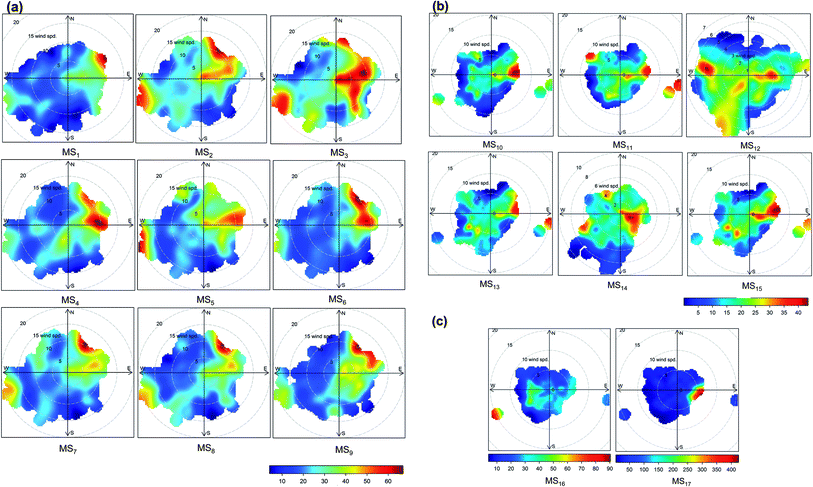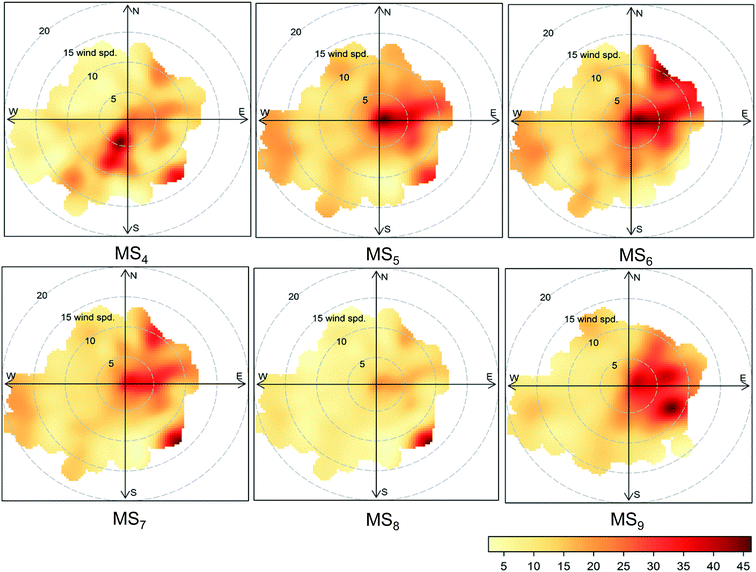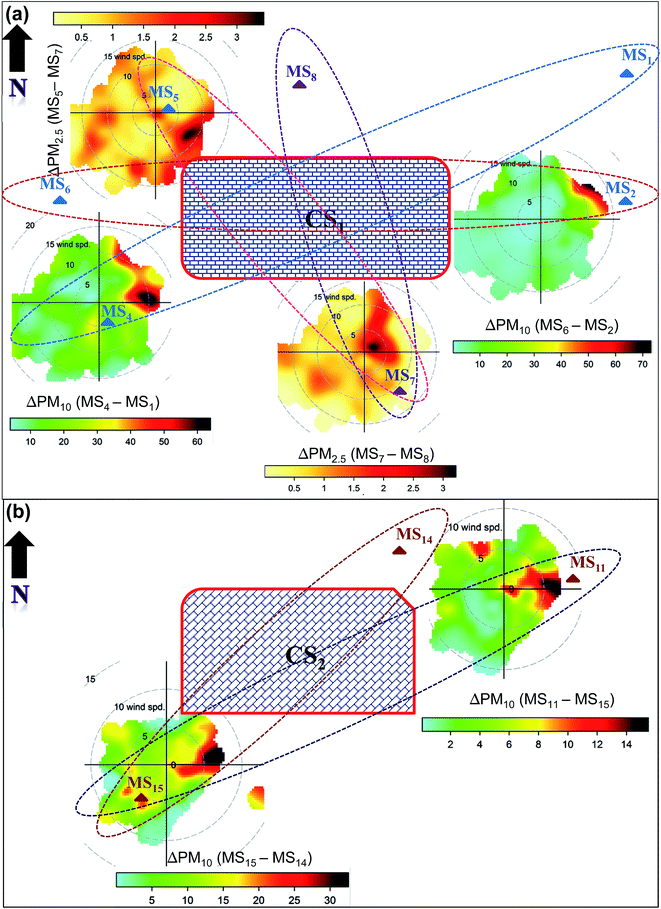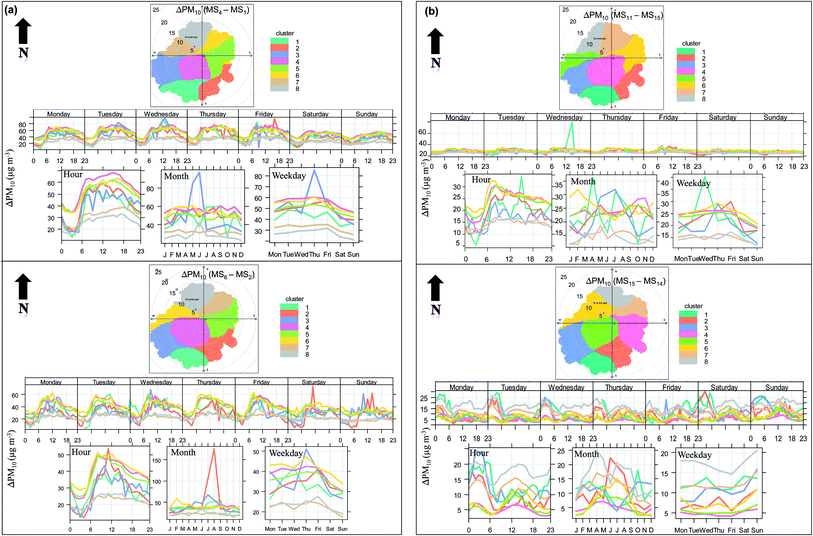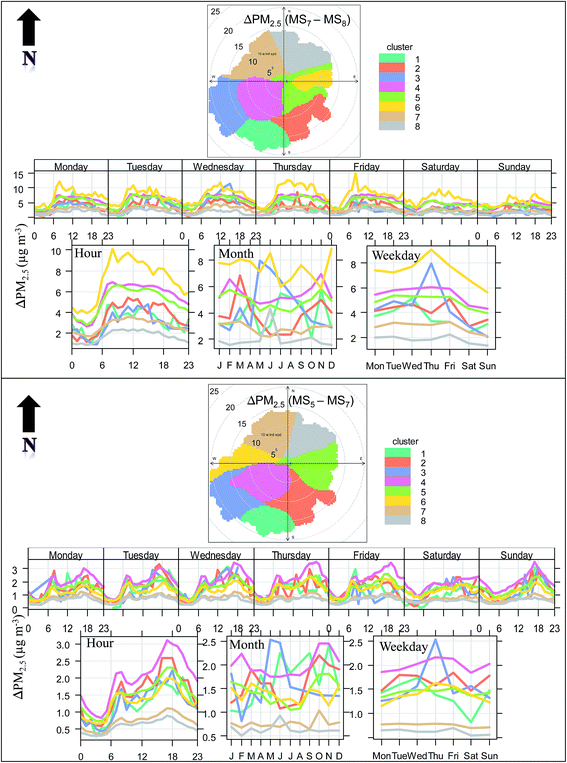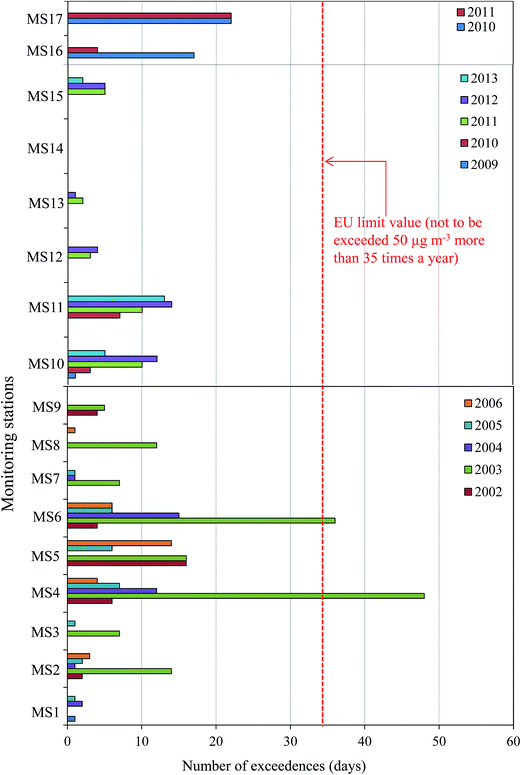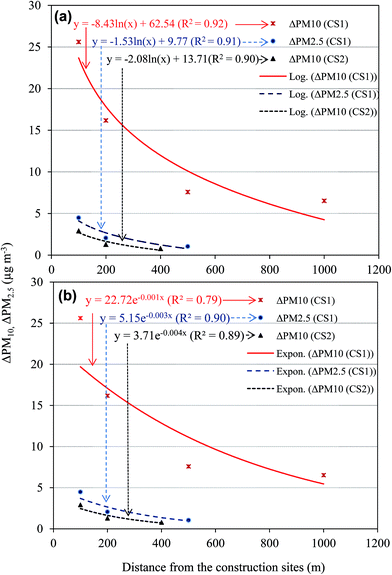 Open Access Article
Open Access ArticleCreative Commons Attribution 3.0 Unported Licence
Assessment of the long-term impacts of PM10 and PM2.5 particles from construction works on surrounding areas†
Farhad
Azarmi
a,
Prashant
Kumar
*ab,
Daniel
Marsh
c and
Gary
Fuller
c
aDepartment of Civil and Environmental Engineering, Faculty of Engineering and Physical Sciences, University of Surrey, Guildford GU2 7XH, UK. E-mail: P.Kumar@surrey.ac.uk; Prashant.Kumar@cantab.net; Fax: +44 (0)1483 682135; Tel: +44 (0)1483 682762
bEnvironmental Flow (EnFlo) Research Centre, Faculty of Engineering and Physical Sciences, University of Surrey, Guildford GU2 7XH, UK
cMRC PHE Centre for Environment and Health, King's College London, London SE1 9NH, UK
First published on 7th December 2015
Abstract
Construction activities are common across cities; however, the studies assessing their contribution to airborne PM10 (≤10 μm) and PM2.5 (≤2.5 μm) particles on the surrounding air quality are limited. Herein, we assessed the impact of PM10 and PM2.5 arising from construction works in and around London. Measurements were carried out at 17 different monitoring stations around three construction sites between January 2002 and December 2013. Tapered element oscillating microbalance (TEOM 1400) and OSIRIS (2315) particle monitors were used to measure the PM10 and PM2.5 fractions in the 0.1–10 μm size range along with the ambient meteorological data. The data was analysed using bivariate concentration polar plots and k-means clustering techniques. Daily mean concentrations of PM10 were found to exceed the European Union target limit value of 50 μg m−3 at 11 monitoring stations but remained within the allowable 35 exceedences per year, except at two monitoring stations. In general, construction works were found to influence the downwind concentrations of PM10 relatively more than PM2.5. Splitting of the data between working (0800–1800 h; local time) and non-working (1800–0800 h) periods showed about 2.2-fold higher concentrations of PM10 during working hours when compared with non-working hours. However, these observations did not allow to conclude that this increase was from the construction site emissions. Together, the polar concentration plots and the k-means cluster analysis applied to a pair of monitoring stations across the construction sites (i.e. one in upwind and the other in downwind) confirmed the contribution of construction sources on the measured concentrations. Furthermore, pairing the monitoring stations downwind of the construction sites showed a logarithmic decrease (with R2 about 0.9) in the PM10 and PM2.5 concentration with distance. Our findings clearly indicate an impact of construction activities on the nearby downwind areas and a need for developing mitigation measures to limit their escape from the construction sites.
Environmental impactConstruction activities have potential to increase the local concentrations of coarse and fine particles, which adversely affect public health. Increased construction activities are expected to cope with the growing world population, which highlights the importance of particle emissions from these sources. This study assesses the impact of PM10 (≤10 μm) and PM2.5 (≤2.5 μm) arising from outdoor construction works on the surrounding environment in London. Increased concentrations at monitoring stations downwind of the construction sites suggest a need to develop efficient mitigation strategies to limit the escape of particulate matter from construction sites. |
1. Introduction
Construction developments in both the developing and developed world are common. However, the impact of particulate matter (PM) emitted in the coarse (PM2.5–10; between 2.5 and 10 μm) and fine (PM2.5 ≤ 2.5 μm) particle size range from such activities on the surrounding areas is poorly understood. Construction and demolition of structures is known to result in higher local concentrations of PM10, which contains a wide variety of toxic organic substances and may adversely affect the respiratory health of nearby residents.1–5 There is also an increased interest in PM2.5 because it penetrates deeper into the lungs and is of even greater concern for human health.6–8 For this reason, exposure to PM2.5 is globally the 9th most powerful risk factor for disease burden.9,10 Until recently, only limited study has focused on the exposure to PM10 and even less research on exposure to PM2.5 fractions arising from outdoor construction activities and understanding their potential impact on local air quality (Table 1).| Activity type | Pollutant type | Characteristics | Reference |
|---|---|---|---|
| Building and road works | PM10 | Outdoor (at over 80 monitoring sites in and around London, UK) | Fuller and Green13 |
| Building implosion | PM10 | Outdoor (22-story building in east Baltimore, USA) | Beck et al.32 |
| Building demolition | PM10 | Outdoor (three public housing developments in Chicago, USA) | Dorevitch et al.33 |
| Building demolition | PM10 | Outdoor (demolition of an old four-story building on the premises of the University Hospital of Essen, Germany) | Hansen et al.31 |
| Construction activities | PM10 | Outdoor (construction and operational activities at a port in Mumbai, India) | Joseph et al.34 |
| Earthmoving activities | PM10 and PM2.5 | Outdoor (earth moving activities conducted at two Kansas sites, Kansas city, USA) | Muleski et al.36 |
| Road widening and construction activities | PM10 and PM2.5 | Outdoor (road widening and related construction works in London, UK) | Font et al.57 |
Besides construction activities, PM10 concentrations are also affected by the emissions arising from local fugitive sources such as road works,11–15 vehicle exhaust16–20 and non-vehicle exhaust sources.21–26 At the same time, many activities associated with air and sea transportation produce particles across the range of PM10 and PM2.5.27–29 A few studies have investigated the PM10 emissions arising from industrial sources such as waste transfer stations.30 There are also a few studies concerned with PM10 emissions arising from outdoor construction activities.31–35 However, there is still very little work focused on PM2.5 fractions arising from construction activities.36
The importance of particle exposure from construction sources is expected to increase with the ever growing world population.37,38 In addition to concerns associated with the short-term exposure to airborne PM at the time of construction activities, there is also the potential for long-term exposure to PM that settles across the nearby community, which is then available for inhalation or ingestion after resuspension.32,39,40
The European Union41 set the targets to limit the daily and annual mean values of PM10 at a European-wide level for the years 2004 and 2010.13 The legal limit by 2005 was to achieve a daily mean PM10 concentration of 50 μg m−3, not exceeded on more than 35 occasions per year and annual mean values of 40 μg m−3. Moreover, the target by 2010 was to achieve a daily mean PM10 concentration of 50 μg m−3, not exceeded on more than 7 occasions per year and annual mean concentrations of 20 μg m−3. These target values, to be met by 2010, were not carried forward in Directive 2008/50/EC.42 Fuller and Green13 noted that the PM10 emissions generated by building and road works in and around London breached the EU limits for the daily mean PM10 concentrations (50 μg m−3) on several occasions. In this study, a series of PM10 and PM2.5 measurements at 17 monitoring stations around construction sites were carried out during 2002–2013 to assess their impact on the air quality in the surrounding areas.
2. Materials and methods
2.1 Description of the construction sites
Measurements were carried out around three outdoor construction sites, which are referred hereafter as CS1, CS2 and CS3. CS1, CS2 and CS3 covered an area of about 260 × 104, 54 × 104 and 3 × 104 m2, respectively (Fig. 1). There were 17 monitoring stations (i.e. MS1–MS17) around these three outdoor construction sites (CS1, CS2 and CS3), which represent a diverse range of construction activities. The locations of the monitoring stations around these sites are shown in Fig. 1, but the specific details about the location have been kept anonymous for the protection of confidential information.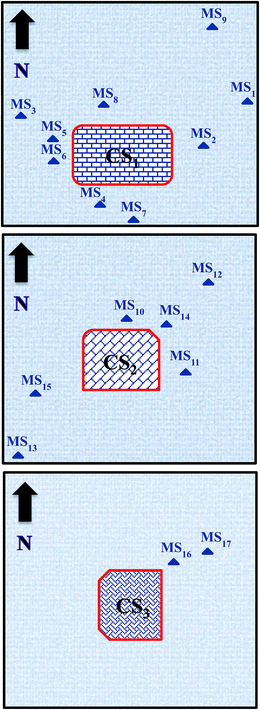 | ||
| Fig. 1 Schematic of the experimental set-up showing the monitoring stations (MS) and construction sites (CS). Please note that the figure is not to scale and the distances are presented in Table 2. | ||
2.2 Field measurements
Continuous air quality monitoring was carried out at 17 different monitoring stations around three construction sites to measure the concentration of PM10 and PM2.5. The measurements of PM concentrations analysed in this study were during the periods of construction and there were no similar measurements made before and/or after the construction works. Measurements were undertaken continuously and divided into working hours (referred to as working period) in weekdays between 08:00 and 18:00 h (local time) and non-working hours (referred to as non-working period), which covered the weekdays between 18:00 and 08:00 h and the weekends. Data were collected over a period of about 4000 days for about 12 years between 2002 and 2013 at the 17 different monitoring sites around CS1–CS3 (Table 2). A diverse range of construction works during the different phases of the construction were anticipated at the studied sites. However, we did not have access to information of the different phases of the construction processes at each site, except the overall duration of the works.| Site code | Duration | Species monitored | Instrument used | Location (distance of the MS from CS) |
|---|---|---|---|---|
| MS1 | January 2002–January 2007 | PM10 | TEOM 1400 | CS1 (3000 m) |
| MS2 | January 2002–January 2007 | PM10 | TEOM 1400 | CS1 (500 m) |
| MS3 | January 2002–January 2007 | PM10 | TEOM 1400 | CS1 (500 m) |
| MS4 | January 2002–January 2007 | PM10, PM2.5 | TEOM 1400 | CS1 (100 m) |
| MS5 | January 2002–January 2007 | PM10, PM2.5 | TEOM 1400 | CS1 (200 m) |
| MS6 | January 2002–January 2007 | PM10, PM2.5 | TEOM 1400 | CS1 (200 m) |
| MS7 | January 2002–January 2007 | PM10, PM2.5 | TEOM 1400 | CS1 (500 m) |
| MS8 | January 2002–January 2007 | PM10, PM2.5 | TEOM 1400 | CS1 (500 m) |
| MS9 | January 2002–January 2007 | PM10, PM2.5 | TEOM 1400 | CS1 (4000 m) |
| MS10 | January 2009–December 2013 | PM10 | OSIRIS 2315 | CS2 (100 m) |
| MS11 | December 2009–May 2013 | PM10 | OSIRIS 2315 | CS2 (200 m) |
| MS12 | November 2008–December 2013 | PM10 | OSIRIS 2315 | CS2 (1000 m) |
| MS13 | January 2009–December 2013 | PM10 | OSIRIS 2315 | CS2 (3000 m) |
| MS14 | May 2013–December 2013 | PM10 | OSIRIS 2315 | CS2 (100 m) |
| MS15 | January 2009–October 2014 | PM10 | OSIRIS 2315 | CS2 (400 m) |
| MS16 | June 2011–August 2012 | PM10 | OSIRIS 2315 | CS3 (100 m) |
| MS17 | June 2011–August 2012 | PM10 | OSIRIS 2315 | CS3 (50 m) |
Data were analysed with reference to the EU Limit Values for annual and daily PM10 concentrations. In addition, bivariate plots were drawn to qualitatively assess the effects of wind speed and direction on the measured concentrations in upwind and downwind directions from construction sites. The k-means clustering technique was then applied to assess contribution of probable local construction sources, which were identified through bivariate polar plots of paired monitoring stations (i.e. one in upwind and the other in downwind). The k-means clustering technique helped to identify the range of increases in particle mass concentrations due to the construction operations, including the resuspension and emissions from any on-site vehicles.43 Moreover, the frequency and variation in PM10 and PM2.5 concentration in the prevailing wind direction were evaluated with changes in distance from sources by pairing the sites in downwind of the CS1–CS3 to assess the decay profile of the PM emissions, which is important to understand the impact of the construction works on the air quality in surrounding areas.
2.3 Instrumentation
PM concentrations at CS1 were collected using a Tapered Element Oscillating Monitor (TEOM 1400) and those at CS2 and CS3 were measured using a Turnkey Osiris instrument (model 2315). Practical constraints, such as space and cost, were important factors in the instrument selection.The TEOM 1400 was used to measure mass of particles per unit volume of air in the size range of 0.1–10 μm. The sampling stream and filters were heated to 50 °C to maintain a stable temperature and to eliminate interference from water on the filter.44 The mass measurement relied on the measurement of the resonant frequency of an oscillating system that consists of the filter and glass element. A correction factor of 1.3 was recommended in the UK for comparison of PM10 measurements from TEOM with the EU Directive 1999/30/EC13,41 prior to the development of a dynamic correction system45,46 and was applied in this study. Further details about the working principle and sensitivity of the TEOM 1400 can be found elsewhere.47–49
The Turnkey Osiris instrument (model 2315) was used to measure the mass distribution of particles per unit volume of air in the 0.4–20 μm size range by light scattering technology in a mass concentration range of 0.1–6000 μg m−3.50 The Osiris instrument is a portable device that is capable of sampling and measuring particle concentrations in real-time with a high temporal resolution (1 s minimum). The air sample is continuously drawn into the instrument by a pump with a flow rate set by the microprocessor at a rate of 0.6 l min−1 through an inlet heated to 50 °C to minimise the effects of water droplets and particle bound water. Over 20![[thin space (1/6-em)]](https://www.rsc.org/images/entities/char_2009.gif) 000 particles per second can be sized before coincidence effects occur. Several size selective inlets are also available for the instrument. These can be used to collect a size selected gravimetric sample on the instrument's filter and will measure in μg m−3. The Osiris instrument also allows wind speed and direction, temperature and relative humidity to be recorded at the same time. The Turnkey Instruments, OSIRIS monitors, have also been used for the assessment of indoor and outdoor PM levels as well as personal exposure in a number of past studies.51,52
000 particles per second can be sized before coincidence effects occur. Several size selective inlets are also available for the instrument. These can be used to collect a size selected gravimetric sample on the instrument's filter and will measure in μg m−3. The Osiris instrument also allows wind speed and direction, temperature and relative humidity to be recorded at the same time. The Turnkey Instruments, OSIRIS monitors, have also been used for the assessment of indoor and outdoor PM levels as well as personal exposure in a number of past studies.51,52
Meteorological data was produced taking a mean from a number of different monitoring locations across the monitoring stations and construction areas wherein the meteorological equipment is considered to be working well and the data shows a good correlation. The measurements were carried out using cup anemometers and wind vanes (as opposed to sonic anemometers) mainly made by Campbell Scientific. This equipment was located at a height of about 10 m.
3. Results and discussion
3.1 Bivariate concentration polar plots
Fig. 2 shows the polar plots that were constructed by partitioning wind speed and direction data and their corresponding hourly mean PM concentration data into different wind speed and direction bins.43 These plots are presented as smoothed surfaces showing the variations in concentration, depending on the local wind direction and wind speed at a receptor.53 The results presented in Fig. 2 show evidence of increased concentrations levels of PM10 and PM2.5 when the wind direction was from the construction sites to the monitoring stations.Closer inspection of polar plots at all 17 monitoring stations around each of the three sites indicates the following: first, whenever there are monitoring stations in the downwind side of the construction sites, high concentrations of PM10 (Fig. 2) and PM2.5 (Fig. 3) are observed, indicating a potential contribution from the construction activities (Fig. 2). Second, pockets of high PM concentrations can also be observed in some cases (for example, observe MS2 for PM10 and MS9 for PM2.5 in Fig. 2a and 3, respectively) despite the monitoring stations being in the upwind of the east and south-west wind directions. This was expected due to long-range transport of PM10 during easterly winds from European countries54,55 and the effect of generated sea salt on PM2.5 from the south-westerly winds.55,56 This observation also suggests that the concentrations measured downwind of the construction sites include some contribution of emissions from these sources and are not solely from the emissions of the construction activities. However, this analysis was inadequate to conclusively report that the measured downwind emissions are from the construction sites. Therefore, paired-site (Section 3.2) and k-means (Section 3.3) analyses were performed to better understand the contributions of the construction emissions during varying wind directions.
3.2 Assessment of the paired sites for examining differences in PM concentrations
We paired the monitoring stations opposite to each other, upwind and downwind of the construction sites to assess the relative changes in the concentrations that may have been contributed by the construction emissions (Fig. 4). We found two pairs of paired monitoring stations each for PM10 and PM2.5 around CS1 (Fig. 4a) and another two pairs for PM10 around CS2 (Fig. 4b), giving a total of 6 paired monitoring stations. This pairing allowed us to measure changes in the concentrations (i.e. ΔPM10 and ΔPM2.5) as air mass crosses the construction sites and the results are presented in Fig. 4. For example, the hourly mean differences in PM10 and PM2.5 at CS1 measured in the two pairs of opposite monitoring stations (MS1, MS4 and MS7, MS8), which were estimated as MS4 minus MS1 and MS7 minus MS8. Likewise, the hourly mean differences at CS2 were calculated using MS14 and MS15 as opposite monitoring stations, which was MS15 minus MS14. Subtraction of the results in the upwind polar plots from those in downwind polar plots clearly shows an increase in the concentrations of PM10 and PM2.5 at all the sites, with all the values being positive and high concentration zone reflecting emissions from the construction sites. Cross-comparison of results between different PM types suggest that the differences are larger for PM10 when compared with PM2.5, suggesting a relatively greater variability in PM10 emissions than those in PM2.5 from construction works. Similar observations were reported by previous studies57 wherein they found greater increases in PM10 compared with PM2.5 from road widening works in London.3.3 k-Means cluster analysis
To identify and independently assess the contribution from local sources, k-means cluster analysis was applied on the 6 paired monitoring stations that were identified and discussed in Section 3.2. Eight different clusters were chosen that were found to be optimal for separating the local source contribution from external sources, based on the recommendations from previous studies.53,58–60Fig. 5 and 6 show the contribution of each cluster in the polar plots of ΔPM10 and ΔPM2.5. The temporal variation of ΔPM10 and ΔPM2.5 contributed by each cluster on an hourly, weekly and monthly basis are also shown. Based on the ΔPM10 and ΔPM2.5 concentrations showing the high concentration peaks in the polar plots (Fig. 4), clusters 5–7 can be identified to represent the concentrations of ΔPM10 (Fig. 5) and ΔPM2.5 (Fig. 6) due to construction sources. If we observe these clusters in the temporal variation plots, peaks can be observed during the weekdays, which are missing during the weekends. This is also demonstrated by the increases in the PM10 and PM2.5 concentrations during 08:00 and 18:00 h, which we referred to as “working hours”. The temporal plots on a monthly basis were examined and the identified clusters (i.e. 5–7) showed relatively lower concentrations during the cold months (i.e. December, January and February) compared with the rest of the months. There could be two possible reasons for these lower concentrations: (i) less construction activity compared to normal and (ii) the weather conditions suppressing the emissions and transport of particles due to relatively wetter conditions than the other months and also affecting the normal construction due to adverse weather conditions. For example, the mean precipitation and relative humidity is expected to be higher during winter months (e.g. 256 mm and 85% to 213 mm and 70% during summer) and low temperature (e.g. mean ∼4 °C to 15 °C during summer).61 Past studies have found wet conditions such as water spraying an effective method to suppress coarse particle emissions by up to 13-times during construction works.62 Detailed receptor modelling studies could help further in drawing firm conclusions.
3.4 Particle mass concentrations during working and non-working hours
Fig. 7 shows the annual mean PM10 and PM2.5 concentrations at the three construction sites. The annual average in PM10 concentrations were found to be 22.9 ± 3.3 μg m−3, 18.8 ± 2.2 μg m−3 and 34.9 ± 2.8 μg m−3 at CS1 (Table 3), CS2 (Table 5) and CS3 (Table 6), respectively, whereas the annual average PM2.5 concentrations were 14.0 ± 1.7 μg m−3 at CS1 (Table 4). These averages include both the working and non-working hours and the averages for these separate durations are presented in ESI Fig. S1a and S2 and described in ESI Sections S1–S2.† Depending on the source and distance from the monitoring stations, the values of PM10 and PM2.5 varied and the concentrations in all cases increased as the working period started (ESI Fig. S1–S4†).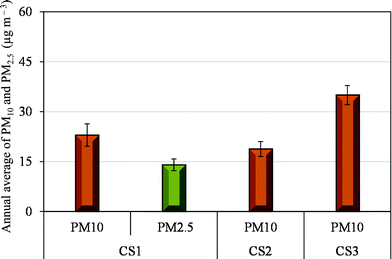 | ||
| Fig. 7 The annual average concentrations of PM10 (17 monitoring stations) during the 2002–2013 period at (a) CS1, (b) CS2, and (c) CS3. | ||
| Year | Monitoring stations | ||||||||
|---|---|---|---|---|---|---|---|---|---|
| MS1 | MS2 | MS3 | MS4 | MS5 | MS6 | MS7 | MS8 | MS9 | |
| 2002 | — | 21.9 ± 12.2 | 19.1 ± 11.2 | 29.5 ± 22.3 | 27.5 ± 20.9 | 23.6 ± 15.6 | 19.3 ± 10.5 | 19.4 ± 10.2 | 24.3 ± 14.4 |
| 2003 | — | 24.5 ± 15.7 | 21.2 ± 12.9 | 36.7 ± 32.1 | 26.8 ± 18.6 | 31.3 ± 27.9 | 22.1 ± 14.0 | 23.8 ± 15.5 | 22.1 ± 13.7 |
| 2004 | 19.1 ± 11.5 | 21.2 ± 11.9 | 17.3 ± 9.5 | 28.9 ± 23.5 | 21.8 ± 13.1 | 25.1 ± 25.5 | 18.7 ± 11.3 | 20.5 ± 11.8 | 25.9 ± 17.0 |
| 2005 | 19.6 ± 10.6 | 23.9 ± 12.1 | 17.4 ± 10.9 | 26.7 ± 21.5 | 23.2 ± 14.1 | 23.9 ± 19.4 | 19.1 ± 10.4 | 19.6 ± 10.2 | — |
| 2006 | 20.4 ± 11.2 | 24.5 ± 23.5 | 18.8 ± 9.8 | 24.8 ± 18.0 | 24.5 ± 20.8 | 22.9 ± 15.5 | 20.6 ± 10.8 | 21.2 ± 11.7 | — |
| Overall average | 19.9 ± 11.1 | 23.2 ± 15.1 | 18.7 ± 10.9 | 29.3 ± 23.5 | 24.7 ± 17.5 | 25.3 ± 20.8 | 20.0 ± 11.4 | 20.9 ± 11.9 | 24.1 ± 9.0 |
| Year | Monitoring stations | ||||||||
|---|---|---|---|---|---|---|---|---|---|
| MS1 | MS2 | MS3 | MS4 | MS5 | MS6 | MS7 | MS8 | MS9 | |
| 2002 | — | — | — | 17.3 ± 17.9 | 13.0 ± 8.0 | 12.5 ± 8.0 | 12.0 ± 8.1 | 11.8 ± 7.2 | 12.6 ± 7.9 |
| 2003 | — | — | — | 15.5 ± 13.6 | 14.5 ± 10.3 | 14.0 ± 9.9 | 14.2 ± 10.4 | 15.5 ± 10.7 | 17.4 ± 10.1 |
| 2004 | — | — | — | 17.0 ± 18.4 | 12.6 ± 7.4 | 11.5 ± 7.9 | 11.5 ± 7.4 | 12.1 ± 7.5 | 19.4 ± 13.3 |
| 2005 | — | — | — | 15.4 ± 16.3 | 12.9 ± 8.2 | 11.9 ± 8.2 | 11.9 ± 7.5 | 12.0 ± 7.4 | — |
| 2006 | — | — | — | 14.6 ± 12.9 | 13.0 ± 8.0 | 12.1 ± 8.0 | 12.1 ± 7.8 | 12.9 ± 7.4 | — |
| Overall average | — | — | — | 16.0 ± 15.8 | 13.2 ± 8.4 | 12.9 ± 8.4 | 12.4 ± 8.2 | 12.9 ± 8.0 | 16.5 ± 6.2 |
| Year | Monitoring stations | |||||
|---|---|---|---|---|---|---|
| MS10 | MS11 | MS12 | MS13 | MS14 | MS15 | |
| 2009 | 24.8 ± 15.5 | 18.2 ± 11.0 | 19.3 ± 11.6 | 14.7 ± 7.9 | — | 15.5 ± 9.2 |
| 2010 | 23.6 ± 16.8 | 17.2 ± 11.2 | — | 15.7 ± 13.9 | — | 14.8 ± 10.3 |
| 2011 | 25.1 ± 18.3 | 18.7 ± 12.6 | — | 20.4 ± 11.8 | — | 20.0 ± 13.2 |
| 2012 | 22.2 ± 16.1 | 18.6 ± 13.7 | — | 16.4 ± 9.7 | — | 18.0 ± 15.4 |
| 2013 | 19.7 ± 12.8 | 15.6 ± 9.4 | — | 20.0 ± 11 | 17.4 ± 12.7 | 19.1 ± 13.6 |
| Overall average | 23.1 ± 16.1 | 17.7 ± 12.3 | 19.3 ± 11.6 | 17.4 ± 11.2 | 17.4 ± 12.7 | 17.5 ± 13.1 |
| Year | Monitoring stations | |
|---|---|---|
| MS16 | MS17 | |
| 2011 | 37.3 ± 33.0 | 35.3 ± 31.2 |
| 2012 | 28.5 ± 24.3 | 38.6 ± 24.6 |
| Overall average | 32.9 ± 19.3 | 34.9 ± 18.1 |
In general, the concentrations observed during the working hours were higher than those during non-working hours (ESI Tables S1–S4†), presumably due to construction activities and the other emission sources such as road vehicles in operation during working hours. Moreover, exhaust and non-exhaust construction sources were at rest during the non-working hours and therefore these are unlikely to contribute to the observed variations during the night. Because there was no major roadway around CS1, the variation in particle mass concentrations (PMCs) between the three construction sites during working and non-working hours could be attributed to the variability in meteorological conditions (mainly wind speed and direction; Fig. 2 and 3) during the different years of the measurements. Overall, the PM10 values were about ∼24%, 18% and 120% larger during the working periods when compared with those observed during the non-working periods at CS1, CS2 and CS3, respectively. Moreover, at CS1, there was an increase of about 11% in PM2.5 values during the working period when compared with the non-working periods (ESI Fig. S2†).
A comparison of the 24 hour average concentrations of PM10 with the EU Directive 2008/50/EC,42 as described in Table 7, suggests the number of exceedences each year (Table 8 and ESI Fig. S5†). However, these exceedences are not expected to be due to construction works alone, given that the winds were blowing from various directions (Fig. 1 and 2) and the presence of nearby sources could also have made a contribution to these exceedences. Therefore, we filtered the data based on the wind direction on an hourly basis at each monitoring station (Fig. 8). The monitoring stations downwind of the construction sites were then considered for the comparison with the 24 h mean EU limit value of 50 μg m−3 to observe the influence of construction works on the exceedences. The values in the parenthesis in Table 8 shows these exceedences possibly due to the construction activities, which were, except on two occasions in 2003 (Table 8), less than the allowable 35 exceedences per year (Table 7). Unlike previous studies13 where the exceedences of daily mean PM10 concentrations were reported over the EU limit value of 50 μg m−3 on several occasions during the monitoring of emissions from road and building works in London, our exceedences are within the regulatory limits and could also be attributed to the construction works, given that the paired polar roses and k-means clusters analysis in Sections 3.1–3.3 suggesting a clear contribution of the construction works on the downwind monitoring stations.
| Pollutant | Period of averaging | Limit values | Dates to achieve |
|---|---|---|---|
| a The EU Directive 1999/30/EC stipulates that the annual mean values of PM10 should be less than 20 μg m−3 and should not exceed a mean of greater than 50 μg m−3 more than 7 days in a year as per the 2010 target limit values. These target values to be met by 2010 were not carried forward in the Directive 2008/50/EC.42 | |||
| EU limit value | |||
| PM10 | 24 hour mean | 50 μg m−3 not to be exceeded more than 35 times a year | January 2005 |
| Calendar year | 40 μg m−3 | January 2005 | |
| 24 hour mean | 50 μg m−3 not to be exceeded morea than 7 times a year (target limit value) | January 2010 | |
| Calendar year | 20 μg m−3 (target limit value)a | January 2010 | |
![[thin space (1/6-em)]](https://www.rsc.org/images/entities/char_2009.gif) |
|||
| UK government AQS objective | |||
| PM10 | 24 hour mean | 50 μg m−3 not to be exceeded more than 10–14 times a year | January 2010 |
| Calendar year | 23–25 μg m−3 | January 2010 | |
| Monitoring stations | Monitoring years | |||||||||||
|---|---|---|---|---|---|---|---|---|---|---|---|---|
| 2002 | 2003 | 2004 | 2005 | 2006 | 2007 | 2008 | 2009 | 2010 | 2011 | 2012 | 2013 | |
| MS1 | 0(0) | 0(0) | 2(2) | 1(1) | 0(0) | — | — | — | — | — | — | — |
| MS2 | 3(2) | 17(14) | 3(1) | 2(2) | 5(3) | — | — | — | — | — | — | — |
| MS3 | 1(0) | 9(7) | 0(0) | 1(1) | 0(0) | — | — | — | — | — | — | — |
| MS4 | 9(6) | 60(48) | 19(12) | 11(7) | 5(4) | — | — | — | — | — | — | — |
| MS5 | 18(16) | 22(16) | 1(0) | 6(6) | 15(14) | — | — | — | — | — | — | — |
| MS6 | 7(4) | 42(36) | 16(15) | 9(6) | 6(6) | — | — | — | — | — | — | — |
| MS7 | 1(0) | 11(7) | 1(1) | 1(1) | 1(0) | — | — | — | — | — | — | — |
| MS8 | 0(0) | 14(12) | 2(0) | 1(0) | 1(1) | — | — | — | — | — | — | — |
| MS9 | 4(4) | 6(5) | 3(0) | 0(0) | 0(0) | |||||||
| MS10 | — | — | — | — | — | — | — | 3(1) | 17(3) | 28(10) | 12(12) | 6(5) |
| MS11 | — | — | — | — | — | — | — | 0(0) | 11(7) | 31(10) | 16(14) | 13(13) |
| MS12 | — | — | — | — | — | — | — | 0(0) | 0(0) | 3(3) | 5(4) | 0(0) |
| MS13 | — | — | — | — | — | — | — | 0(0) | 0(0) | 3(2) | 1(1) | 0(0) |
| MS14 | — | — | — | — | — | — | — | 0(0) | 0(0) | 0(0) | 0(0) | 0(0) |
| MS15 | — | — | — | — | — | — | — | 0(0) | 0(0) | 7(5) | 6(5) | 2(2) |
| MS16 | — | — | — | — | — | — | — | — | — | 20(17) | 4(4) | — |
| MS17 | — | — | — | — | — | — | — | — | — | 25(22) | 33(22) | — |
3.5 Decay profiles of PM10 and PM2.5
The purpose of this section is to evaluate the variation in concentrations of PM10 and PM2.5 at different distances from the construction sites. This analysis assisted in understanding how far the PM concentrations can go to affect the surrounding areas as well as help in planning for emission mitigation measures, particularly for construction sites close to sensitive areas such as hospitals or schools.Fig. 9 shows the decay profiles of the PM10 and PM2.5 concentrations with the changing distance from CS1 and CS2. Both the logarithmic (Fig. 9a) and exponential (Fig. 9b) best-fit functions were applied to our ΔPM10 and ΔPM2.5. The logarithmic decay function (Fig. 9a) was chosen as a best fit to our data based on better R2 values than those given by an exponential decay profile as 0.79, 0.90 and 0.89 for PM10 (CS1), PM10 (CS2) and PM2.5 (CS1), respectively (Fig. 9b). The differences between the hourly averages of PM10 and PM2.5 concentrations (ΔPM10 and ΔPM2.5) during the working and non-working time periods provided the net concentrations from the construction activities, which were then used to draw decay profiles (Fig. 9). Furthermore, the calculated concentrations for PM10 and PM2.5 were filtered on the basis of prevailing wind direction.
The decay profile of the PM10 concentrations at CS1 was drawn using the data measured at MS4, MS5, MS7 and MS3, which were 100, 200, 500 and 1000 m away from CS1, respectively. Moreover, the data measured at MS4, MS6 and MS7 were used to draw the decay profile of PM2.5 at CS1, which were 100, 200 and 500 m away from CS1, respectively. Furthermore, the decay profiles of the PM10 concentrations were measured at 100, 200 and 400 m away from CS2 at MS10, MS11 and MS15, respectively.
Because of atmospheric dilution, the mass concentration dramatically decreased with an increasing distance from the construction site to approximately half of its value at a distance between 100 and 200 m. The best fitting logarithmic decay equations for PM10 were drawn, which gave R2 values of 0.92 and 0.91 for CS1 and CS2, respectively (Fig. 9a). A much higher rate of change in the PM concentrations can be observed close to the construction site when compared with those at greater distances. For instance, the rate of change in PM10 (CS1) concentration with per meter distance was 0.06 μg m−3 in between 100 and 200 m, which decreases to 0.030 and 0.013 μg m−3 per meter distance in the 200–400 m and 400–1000 m range, respectively (Fig. 9a). These observations suggest to measure the PM within a few 100 meters distance from the construction sites to capture the rapid decay in PMCs. The total mean PM2.5 levels around CS1 were also correlated well with the distances. A logarithmic decay profile with R2 value of 0.90 represented the measured data very well.
Although studies measuring the decay of the PM concentrations around the construction sites are rare, we tried to compare our data with the most relevant studies. For example, Hitchins et al.63 determined the PM10 concentration at increasing distances from a road at two sites in Australia. They found that PM2.5 and ultrafine particles decayed by up to half of their maximum initial concentrations within a distance of 100–150 m from the road. Likewise, Buonanno et al.64 found the PM10 concentration values to decrease exponentially away from the freeway in Italy during weekly traffic conditions.
4. Summary and conclusions
OSIRIS (model 2315) and TEOM 1400 were used to measure the mass concentration of particles in the 0.1–10 μm size range around three construction sites at 17 monitoring stations over a period of 12 years between January 2002 and December 2013. The objectives were to understand the emission characteristics of coarse and fine particles from construction activities, identifying their contribution to the ambient levels of PM concentrations in the vicinity of these sites and their spatial decay away from the construction sites.The following conclusions are drawn from this study:
The source characteristics of PM10 and PM2.5 were investigated using bivariate concentration polar plots and k-means clustering techniques. The high concentrations of PM10 and PM2.5 were observed at the paired monitoring stations during the construction works when the winds were blowing from construction sites towards the monitoring stations. A k-means clustering technique provided a useful development to the bivariate polar plots to assess the contribution of construction and other local sources.
Three clusters (5, 6 and 7) from a total of the 8 selected clusters showed strong evidence of a downward increase in PM10 and PM2.5 levels during the weekdays. These clusters were identified to represent construction activities.
PM10 were found about ∼24%, 18% and 120%, and PM2.5 about 11%, larger during the working periods when compared with those during non-working periods at CS1, CS2 and CS3, respectively. These increases were attributed to the construction works as indicated by the bivariate concentration polar plots and k-means clustering analysis. In addition, the downwind concentrations of PM10 were found to be relatively more influenced by construction works at CS1 than the PM2.5 concentrations.
The 24 h mean EU limit of value of 50 μg m−3 set by EU Directives for PM10 not to be exceeded more than 35 times a calendar year was breached on two occasions due to construction operations on downwind monitoring stations during the measurements taken between 2002 and 2013.
Both the total PM10 and PM2.5 values during working periods in the downwind direction were found to be well correlated with distance with R2 values over 0.90 in a logarithmic form. These concentrations reduced to half of their initial concentrations within a few 100 meters. This indicates that placing a monitoring station around a site within this peripheral distance could help capture the rapid decay of particles escaping from the construction sites.
The results presented in this study highlight the contributions of PM10 and PM2.5 from construction works. The increase in the concentrations of PM10 and PM2.5 at the downwind monitoring stations suggest that there is a need to design more detailed and appropriate risk mitigation strategies to limit the exposure to onsite workers and people that live in the surrounding environment. Further studies covering chemical fingerprinting of size fractionated PM from construction operations are recommended to understand their chemical composition as well as apportioning construction dust (e.g. using calcium and other similar minerals as a marker) from the exhaust emissions of construction machinery (e.g. using black carbon as a marker65), together with allowing to differentiate between the properties of construction dust and the PM produced by the most common source (i.e. road vehicles) in urban environments.16,66
Acknowledgements
The authorswould like to thank the University of the Surrey and Cara for supporting this study. The authors would like to thank the anonymous reviewers for their time to read the manuscript. We would like to thank the construction site managers for permitting the use of their measurements.References
- M. R. Heal, P. Kumar and R. M. Harrison, Chem. Soc. Rev., 2012, 41, 6606–6630 RSC.
- A. F. Davila, D. Rey, K. Mohamed, B. Rubio and A. P. Guerra, Environ. Sci. Technol., 2006, 40, 3922–3928 CrossRef CAS PubMed.
- H. R. Anderson, Atmos. Environ., 2009, 43, 142–152 CrossRef CAS.
- D. Loomis, Epidemiology, 2000, 11, 2 CrossRef CAS PubMed.
- B. Brunekreef and S. T. Holgate, Lancet, 2002, 360, 1233–1242 CrossRef CAS.
- C. A. Pope, J. Aerosol Med., 2000, 13, 335–354 CrossRef PubMed.
- A. Chaloulakou, P. Kassomenos, N. Spyrellis, P. Demokritou and P. Koutrakis, Atmos. Environ., 2003, 37, 649–660 CrossRef CAS.
- J. Pekkanen, K. L. Timonen, J. Ruuskanen, A. Reponen and A. Mirme, Environ. Res., 1997, 74, 24–33 CrossRef CAS PubMed.
- S. S. Lim, T. Vos, A. D. Flaxman, G. Danaei, K. Shibuya, H. Adair-Rohani, M. A. AlMazroa, M. Amann, H. R. Anderson and K. G. Andrews, Lancet, 2013, 380, 2224–2260 CrossRef.
- G. Oberdörster, Int. Arch. Occup. Environ. Health, 2000, 74, 1–8 CrossRef.
- F. Amato, M. Pandolfi, A. Escrig, X. Querol, A. Alastuey, J. Pey, N. Perez and P. K. Hopke, Atmos. Environ., 2009, 43, 2770–2780 CrossRef CAS.
- G. W. Fuller, D. C. Carslaw and H. W. Lodge, Atmos. Environ., 2002, 36, 1431–1441 CrossRef CAS.
- G. W. Fuller and D. Green, Atmos. Environ., 2004, 38, 4993–5002 CrossRef CAS.
- K. Ho, S. Lee, J. C. Chow and J. G. Watson, Atmos. Environ., 2003, 37, 1023–1032 CrossRef CAS.
- G. Tian, S. Fan, G. Li and J. Qin, Huanjing Kexue, 2007, 28, 2626–2629 CAS.
- P. Kumar, A. Robins, S. Vardoulakis and R. Britter, Atmos. Environ., 2010, 44, 5035–5052 CrossRef CAS.
- P. Kumar, A. Robins, S. Vardoulakis and P. Quincey, Particulogy, 2011, 9, 566–571 CrossRef CAS.
- M. Abu-Allaban, J. Gillies, A. Gertler, R. Clayton and D. Proffitt, Environ. Monit. Assess., 2007, 132, 155–163 CrossRef CAS PubMed.
- S. H. Cadle, P. A. Mulawa, E. C. Hunsanger, K. Nelson, R. A. Ragazzi, R. Barrett, G. L. Gallagher, D. R. Lawson, K. T. Knapp and R. Snow, Environ. Sci. Technol., 1999, 33, 2328–2339 CrossRef CAS.
- A. J. Kean, R. F. Sawyer and R. A. Harley, J. Air Waste Manage. Assoc., 2000, 50, 1929–1939 CAS.
- J. C. Chow, J. G. Watson, J. L. Mauderly, D. L. Costa, R. E. Wyzga, S. Vedal, G. M. Hidy, S. L. Altshuler, D. Marrack and J. M. Heuss, J. Air Waste Manage. Assoc., 2006, 56, 1368–1380 CAS.
- M. Dall'Osto, A. Thorpe, D. Beddows, R. Harrison, J. Barlow, T. Dunbar, P. Williams and H. Coe, Atmos. Chem. Phys., 2011, 11, 6623–6637 CrossRef.
- P. K. Hopke, R. E. Lamb and D. F. S. Natusch, Environ. Sci. Technol., 1980, 14, 164–172 CrossRef CAS.
- P. Kumar and L. Morawska, Atmos. Environ., 2014, 90, 51–58 CrossRef CAS.
- P. Kumar, L. Pirjola, M. Ketzel and R. M. Harrison, Atmos. Environ., 2013, 67, 252–277 CrossRef CAS.
- N. Saliba, F. El Jam, G. El Tayar, W. Obeid and M. Roumie, Atmos. Res., 2010, 97, 106–114 CrossRef CAS.
- G. E. Andrews, I. D. Andrews, D. W. Dixon-Hardy, B. M. Gibbs, H. Li and S. Wright, ASME Turbo Expo 2010: Power for Land, Sea, and Air, American Society of Mechanical Engineers, 2010, pp. 363–375 Search PubMed.
- J. J. Corbett, J. J. Winebrake, E. H. Green, P. Kasibhatla, V. Eyring and A. Lauer, Environ. Sci. Technol., 2007, 41, 8512–8518 CrossRef CAS PubMed.
- T. S. Bates, P. K. Quinn, D. Coffman, K. Schulz, D. S. Covert, J. E. Johnson, E. J. Williams, B. M. Lerner, W. M. Angevine, S. C. Tucker, W. A. Brewer and A. Stohl, J. Geophys. Res.: Atmos., 2008, 113, D00F01 CrossRef.
- B. M. Barratt and G. W. Fuller, Environ. Sci.: Processes Impacts, 2014, 16, 1328–1337 CAS.
- D. Hansen, B. Blahout, D. Benner and W. Popp, J. Hosp. Infect., 2008, 70, 259–264 CrossRef CAS PubMed.
- C. M. Beck, A. Geyh, A. Srinivasan, P. N. Breysse, P. A. Eggleston and T. J. Buckley, J. Air Waste Manage. Assoc., 2003, 53, 1256–1264 Search PubMed.
- S. Dorevitch, H. Demirtas, V. W. Perksy, S. Erdal, L. Conroy, T. Schoonover and P. A. Scheff, J. Air Waste Manage. Assoc., 2006, 56, 1022–1032 CAS.
- J. Joseph, R. S. Patil and S. K. Gupta, Environ. Monit. Assess., 2009, 159, 85–98 CrossRef CAS PubMed.
- S. Upton, Effects of a construction site on local PM10 levels, presentation at the Investigation of Air Pollution Standing Conference, Manchester, June 2002 Search PubMed.
- G. E. Muleski, C. Cowherd and J. S. Kinsey, J. Air Waste Manage. Assoc., 2005, 55, 772–783 CAS.
- C. O. Egbu, Construction Management and Economics, 1999, 17, 29–43 CrossRef.
- A. Kousa, J. Kukkonen, A. Karppinen, P. Aarnio and T. Koskentalo, Atmos. Environ., 2002, 36, 2109–2119 CrossRef CAS.
- P. J. Lioy, C. P. Weisel, J. R. Millette, S. Eisenreich, D. Vallero, J. Offenberg, B. Buckley, B. Turpin, M. Zhong and M. D. Cohen, Environ. Health Perspect., 2002, 110, 703 CrossRef CAS PubMed.
- M. Abu-Allaban, S. Hamasha and A. Gertler, J. Air Waste Manage. Assoc., 2006, 56, 1440–1444 CAS.
- E. U. Directive, Off. J. Eur. Communities: Legis., 1999, 50, 41–60 Search PubMed.
- E. U. Directive, Off. J. Eur. Communities: Legis., 2008, 151, 1–44 Search PubMed.
- D. C. Carslaw and K. Ropkins, Environ. Model. Software, 2012, 27–28, 52–61 CrossRef.
- J. Cyrys, G. Dietrich, W. Kreyling, T. Tuch and J. Heinrich, Sci. Total Environ., 2001, 278, 191–197 CrossRef CAS PubMed.
- F. Defra, TG, 09, 2009.
- D. C. Green, G. W. Fuller and T. Baker, Atmos. Environ., 2009, 43, 2132–2141 CrossRef CAS.
- G. P. Ayers, M. D. Keywood and J. L. Gras, Atmos. Environ., 1999, 33, 3717–3721 CrossRef CAS.
- M. B. Meyer, H. Patashnick, J. L. Ambs and E. Rupprecht, J. Air Waste Manage. Assoc., 2000, 50, 1345–1349 CAS.
- D. Green, G. Fuller and B. Barratt, Atmos. Environ., 2001, 35, 2589–2593 CrossRef CAS.
- V. Tasić, M. Jovašević-Stojanović, S. Vardoulakis, N. Milošević, R. Kovačević and J. Petrović, Atmos. Environ., 2012, 54, 358–364 CrossRef.
- K. Y. Kim, Y. S. Kim, Y. M. Roh, C. M. Lee and C. N. Kim, J. Hazard. Mater., 2008, 154, 440–443 CrossRef CAS PubMed.
- J. Gulliver and D. Briggs, Atmos. Environ., 2004, 38, 1–8 CrossRef CAS.
- D. C. Carslaw and S. D. Beevers, Environ. Model. Software, 2013, 40, 325–329 CrossRef.
- H. E. Smethurst, C. Witham, A. G. Robins and V. S. G. Murray, J. Wind Eng. Ind. Aerod., 2012, 103, 60–72 CrossRef.
- Y.-J. Liu and R. M. Harrison, Atmos. Environ., 2011, 45, 3267–3276 CrossRef CAS.
- A. M. Jones, R. M. Harrison and J. Baker, Atmos. Environ., 2010, 44, 1682–1690 CrossRef CAS.
- A. Font, T. Baker, I. S. Mudway, E. Purdie, C. Dunster and G. W. Fuller, Sci. Total Environ., 2014, 497–498, 123–132 CrossRef CAS PubMed.
- B. Everitt, S. Landau, M. Leese and D. Stahl, Cluster Analysis Wiley Series in Probability and Statistics, Wiley, Chichester, UK, 2011, 5th edn, p. 346 Search PubMed.
- S. Wood, Generalized additive models: an introduction with R, CRC press, 2006 Search PubMed.
- M. A. Elangasinghe, N. Singhal, K. N. Dirks, J. A. Salmond and S. Samarasinghe, Atmos. Environ., 2014, 94, 106–116 CrossRef CAS.
- G. Jenkins, M. Perry and J. Prior, The climate of the United Kingdom and recent trends, Met Office Hadley Centre, Exeter, UK, 2009 Search PubMed.
- P. Kumar, M. Mulheron and C. Som, J. Nanopart. Res., 2012, 14, 771, DOI:10.1007/s11051-012-0771-2.
- J. Hitchins, L. Morawska, R. Wolff and D. Gilbert, Atmos. Environ., 2000, 34, 51–59 CrossRef CAS.
- G. Buonanno, A. Lall and L. Stabile, Atmos. Environ., 2009, 43, 1100–1105 CrossRef CAS.
- M. Viana, T. Kuhlbusch, X. Querol, A. Alastuey, R. Harrison, P. Hopke, W. Winiwarter, M. Vallius, S. Szidat and A. Prevot, J. Aerosol Sci., 2008, 39, 827–849 CrossRef CAS.
- P. Kumar, M. Ketzel, S. Vardoulakis, L. Pirjola and R. Britter, J. Aerosol Sci., 2011, 42, 580–603 CrossRef CAS.
Footnote |
| † Electronic supplementary information (ESI) available: Sections S1–S2, Tables S1–S4 and Fig. S1–S5. See DOI: 10.1039/c5em00549c |
| This journal is © The Royal Society of Chemistry 2016 |

